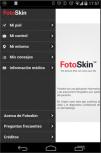Patient skin self-examination has proven to be very useful in the secondary prevention of melanoma.1–4 Various studies show that campaigns to raise awareness and to encourage skin self-examination make it possible to diagnose thinner melanomas, thus improving prognosis.5 Self-examination can be optimized by taking photographs according to a specific protocol.6 This photographic record facilitates identification of new lesions and reveals significant changes in existing ones. An additional advantage of photographic self-examination systems is that they improve patient adherence and accuracy in self-examination.2 Other useful measures in photographic self-examination include comparison of photographs against mole mapping diagrams7 and visual images of benign and malignant lesions.
At present, photographic self-examination by patients aimed at secondary prevention of melanoma is not a habitual practice,8 even though it has proven to be effective.1–4 The reasons for this observation include ignorance of the importance of photographic surveillance, the inconvenience of taking photographs with a camera from which the images then have to be downloaded and stored on a computer, and the lack of adherence to self-examination due to forgetfulness.
We present a technology-based solution to foster patient self-examination, namely, an application for smartphones (FotoSkin®) that enables patients to take regular photographs of their skin according to a specific protocol (mole mapping). These photographs can then be taken to the clinic in order to provide the dermatologist with a more accurate picture of how moles and other types of skin lesions are evolving (Fig. 1). The application also includes 3 sections aimed at improving patients’ knowledge of skin cancer, raising awareness, and, therefore, promoting adherence to self-examination and visits to the dermatologist. The sections are the following: 1) an information section showing the patient the differences between benign lesions and suspicious or malignant lesions; 2) a section with algorithms to determine the phototype, risk of melanoma, and level of actinic damage; and 3) a dynamic section showing the local UV index and providing practical advice on photoprotective measures and healthy sun exposure.
The main objective of FotoSkin® is to act as a photographic record of the patient's moles and other skin lesions that can later be shown to the dermatologist at checkups (Fig. 2). Visualization of changes in the lesions thus improves the dermatologist's diagnostic accuracy and even improves secondary prevention of the melanoma by enabling the patient to see whether the lesions are new or have changed,1 as well as encouraging the patient to adhere to self-examination and checkups. The secondary objective of FotoSkin® is to improve health education about melanoma, skin cancer, and healthy sun exposure habits.
The application was designed for smartphones and tablets, both of which have several advantages over a computer,9 namely, ease of use, rapid photographs and storage, automatic reminders about self-examinations, and, in particular, portability (patients can take their photographs with them when they visit the dermatologist). FotoSkin® is free to download and use and is available for iOS (iPhone, iPad) and for Android.
In conclusion, new technology can help to improve skin self-examination in secondary skin cancer prevention by means of systematized whole-body photographic mapping, reminders, and visits to the dermatologist. It can also help to improve health education and encourage patients to become actively involved in the care and surveillance of their skin.
FundingThe FotoSkin® application was funded by ISDIN. However, ISDIN did not participate in the preparation of the content included in the application.
Conflicts of InterestThe authors declare that they have no conflicts of interest.
Please cite this article as: Vañó-Galván S. Autocontrol fotográfico mediante smartphones para mejorar el diagnóstico precoz del melanoma. Actas Dermosifiliogr. 2015;106:75–77.










